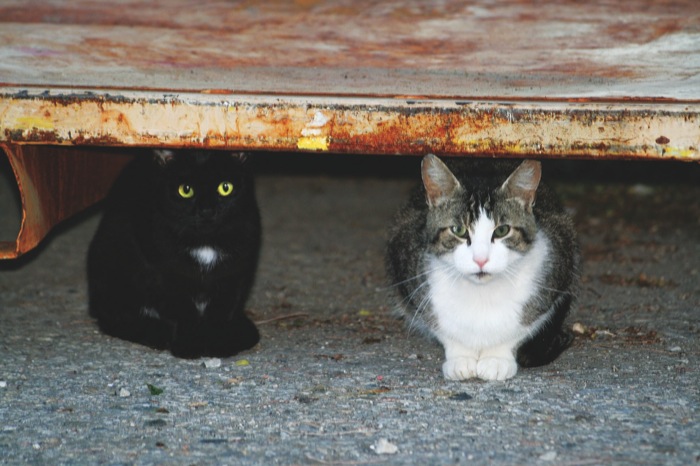Nicholas Maronese
Senior Staff
For Sarah May, late August is kitten season.
“It lasts from about March until November,” says the envionmental studies major. “Most cats start having litters in the spring, but we’re still in the middle of it now.”

It’s one of the busiest times of the year for May, stray cat foster coordinator for Toronto Cat Rescue (TCR), the city’s largest feline rescue group.
That’s because if the cats she rescues from Toronto’s streets are going to be domesticated and adopted, they have to be picked up before they’re eight weeks old.
After eight weeks, they become “feral”—aggressive, wild, and unfriendly to humans. Once feral, they become a part of a colony.
Life in a feral colony is not easy on a stray kitten. They have to struggle to find food, fight off violent, territorial males, and face the threat of getting hit by a car or shot by a frustrated human neighbour. Most don’t live past three or four.
It’s something May and her group are trying to fix. TCR is one of a handful of groups in the Greater Toronto Area dedicated to eradicating feral cat colonies, which at the moment are growing rapidly.
“Throughout the city there’s a feral cat problem, but you’ll find a lot of colonies in any neighbourhood where people move in and out a lot,” says May. “[Neighbourhoods near] schools like York, for example. Students often can’t afford to fix their cat, and leave it behind when they move away.”
May says there are at least three major colonies around the Keele-Jane-Finch area, but if you haven’t noticed, it may be because you’re not looking.
“There are tons of feral cats in the University Heights region,” explains Rosalynne Gelade, president of Urban Cat Relief (UCR), another rescue group. “But they’re like BMWs: if you see them all the time, eventually you don’t notice them.”
TCR, UCR, and other rescue groups in Toronto often work together because they all have the same goal: to get cats off of the streets and into loving homes.

Most groups’ efforts are divided between preventing felines from being abandoned by fostering cats people no longer want; and monitoring and caring for feral colonies, and when possible finding homes for stray kittens.
The emphasis, though, lies on spaying and neutering domestic and feral cats alike, to help control the animal population. Cats are super-successful breeders: they become sexually mature at around four months old, and can have up to three litters—a total of 12 to 24 kittens—per year.
“A majority of people can’t afford to spay or neuter their pets. That’s why colonies are especially bad in low-income neighbourhoods,” May explains. “We need a low-cost spay-and-neuter clinic so people can afford it.”
Gelade says veterinary fees are her group’s biggest expense; a spaying or neutering procedure costs about $150, a sum barely covered by the $175 May’s TCR charges a new owner for a cat adoption.
“Ninety-seven percent of our funds go directly to the cats,” says May.

Both TCR and UCR rely on volunteers, but with over 300,000 cats to manage in the GTA and only a small number of dedicated helpers (TCR has about 50 to 80; UCR, close to five) it’s a lot of hard work.
About a third of TCR’s more sporadic volunteers are high school students getting in the community service hours they need to graduate.
Few are as eager as May, who was denied work in a cat-care shelter because she was too young; at the time, she was under 16. She found other ways to help, and quickly moved on to managing one of TCR’s PetSmart partnerships (the store helps in selling rescued kittens).
Now May is the group’s stray and feral cat foster coordinator: she coordinates feral colony management and decides which cats are taken into the foster system. She also helps set cat traps—but that doesn’t mean what you think.
“There’s no running around with nets,” she explains. “They’re wild, you can’t handle them at all.”
TCR, like most rescue groups, employs a trap, neuter, return, maintain (TNRM) program to systematically neuter feral colonies.
First, trappers establish a feeding schedule for the colony, then bait wire cage traps when they know the cats are hungry. They’re then taken to a vet, vaccinated, spayed or neutered, and “ear tipped” (a clipped left ear tip is the universal sign of a neutered cat). They’ll stay in a recovery home for a few days, and then are released back into the colony.
The goal is to spay the entire colony, slowing down feral breeding and preventing the colony’s population from getting out of control.
Of course, adopting stray-but-not-yet-feral kittens into foster homes helps, too. Cats stay in foster homes temporarily while TCR or UCR look for new owners willing to take them in.
“University students make great foster parents because it lets them care for a cat without making a long-term commitment to it,” says Gelade. “Some students aren’t sure where they’ll be in a few years, but holding on to a kitten for a few months obviously won’t disrupt their plans.”
Foster parents, trappers, fundraisers, and drivers—TCR and UCR need all sorts of volunteers if they’re going to stay on top of Toronto’s growing feral cat population. It’s a problem that’s getting worse every year.
And it’s a problem that grows, of course, during kitten season.
For more information, visit Toronto Cat
Rescue and Urban Cat Relief.



[…] Nine Lives, But None to Spare (Excalibur, 7 September 2011) […]